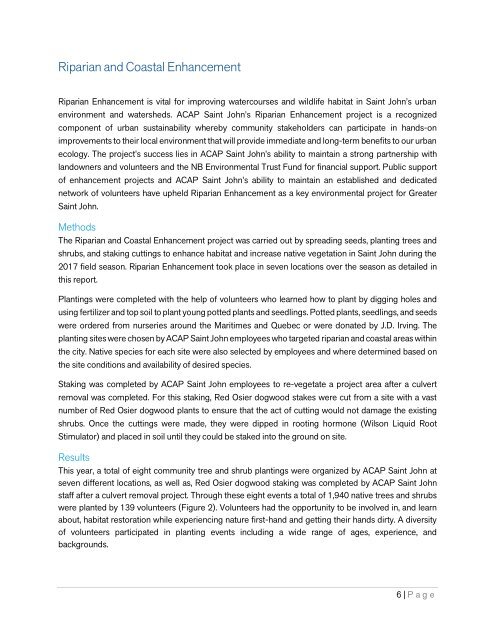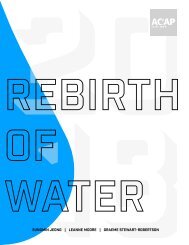10,000 Hands - 2017-2018
Community Environmental Outreach and Education in Saint John, New Brunswick, 2017-2018
Community Environmental Outreach and Education in Saint John, New Brunswick, 2017-2018
You also want an ePaper? Increase the reach of your titles
YUMPU automatically turns print PDFs into web optimized ePapers that Google loves.
Riparian and Coastal Enhancement<br />
Riparian Enhancement is vital for improving watercourses and wildlife habitat in Saint John’s urban<br />
environment and watersheds. ACAP Saint John’s Riparian Enhancement project is a recognized<br />
component of urban sustainability whereby community stakeholders can participate in hands-on<br />
improvements to their local environment that will provide immediate and long-term benefits to our urban<br />
ecology. The project’s success lies in ACAP Saint John’s ability to maintain a strong partnership with<br />
landowners and volunteers and the NB Environmental Trust Fund for financial support. Public support<br />
of enhancement projects and ACAP Saint John’s ability to maintain an established and dedicated<br />
network of volunteers have upheld Riparian Enhancement as a key environmental project for Greater<br />
Saint John.<br />
Methods<br />
The Riparian and Coastal Enhancement project was carried out by spreading seeds, planting trees and<br />
shrubs, and staking cuttings to enhance habitat and increase native vegetation in Saint John during the<br />
<strong>2017</strong> field season. Riparian Enhancement took place in seven locations over the season as detailed in<br />
this report.<br />
Plantings were completed with the help of volunteers who learned how to plant by digging holes and<br />
using fertilizer and top soil to plant young potted plants and seedlings. Potted plants, seedlings, and seeds<br />
were ordered from nurseries around the Maritimes and Quebec or were donated by J.D. Irving. The<br />
planting sites were chosen by ACAP Saint John employees who targeted riparian and coastal areas within<br />
the city. Native species for each site were also selected by employees and where determined based on<br />
the site conditions and availability of desired species.<br />
Staking was completed by ACAP Saint John employees to re-vegetate a project area after a culvert<br />
removal was completed. For this staking, Red Osier dogwood stakes were cut from a site with a vast<br />
number of Red Osier dogwood plants to ensure that the act of cutting would not damage the existing<br />
shrubs. Once the cuttings were made, they were dipped in rooting hormone (Wilson Liquid Root<br />
Stimulator) and placed in soil until they could be staked into the ground on site.<br />
Results<br />
This year, a total of eight community tree and shrub plantings were organized by ACAP Saint John at<br />
seven different locations, as well as, Red Osier dogwood staking was completed by ACAP Saint John<br />
staff after a culvert removal project. Through these eight events a total of 1,940 native trees and shrubs<br />
were planted by 139 volunteers (Figure 2). Volunteers had the opportunity to be involved in, and learn<br />
about, habitat restoration while experiencing nature first-hand and getting their hands dirty. A diversity<br />
of volunteers participated in planting events including a wide range of ages, experience, and<br />
backgrounds.<br />
6 | P age

















